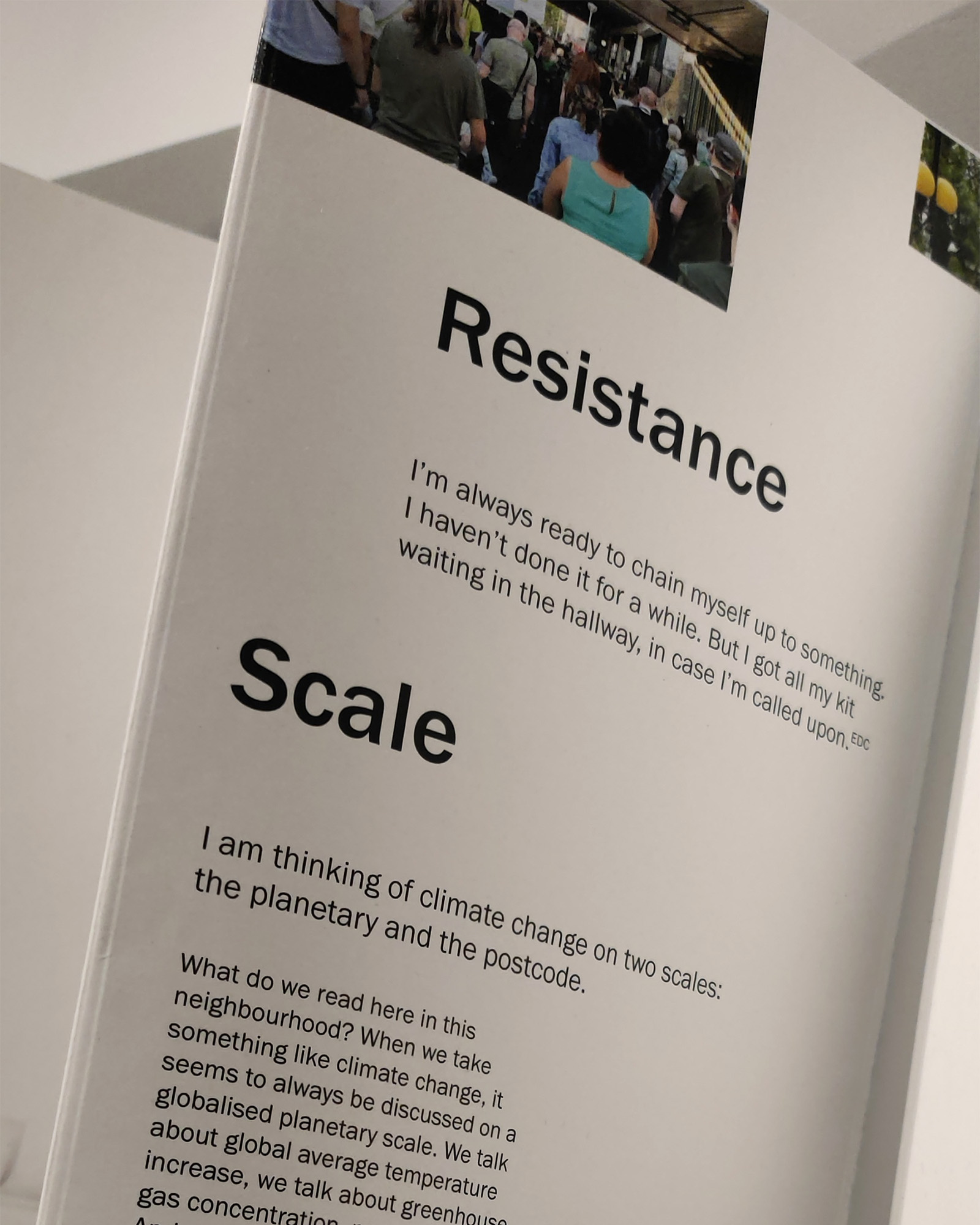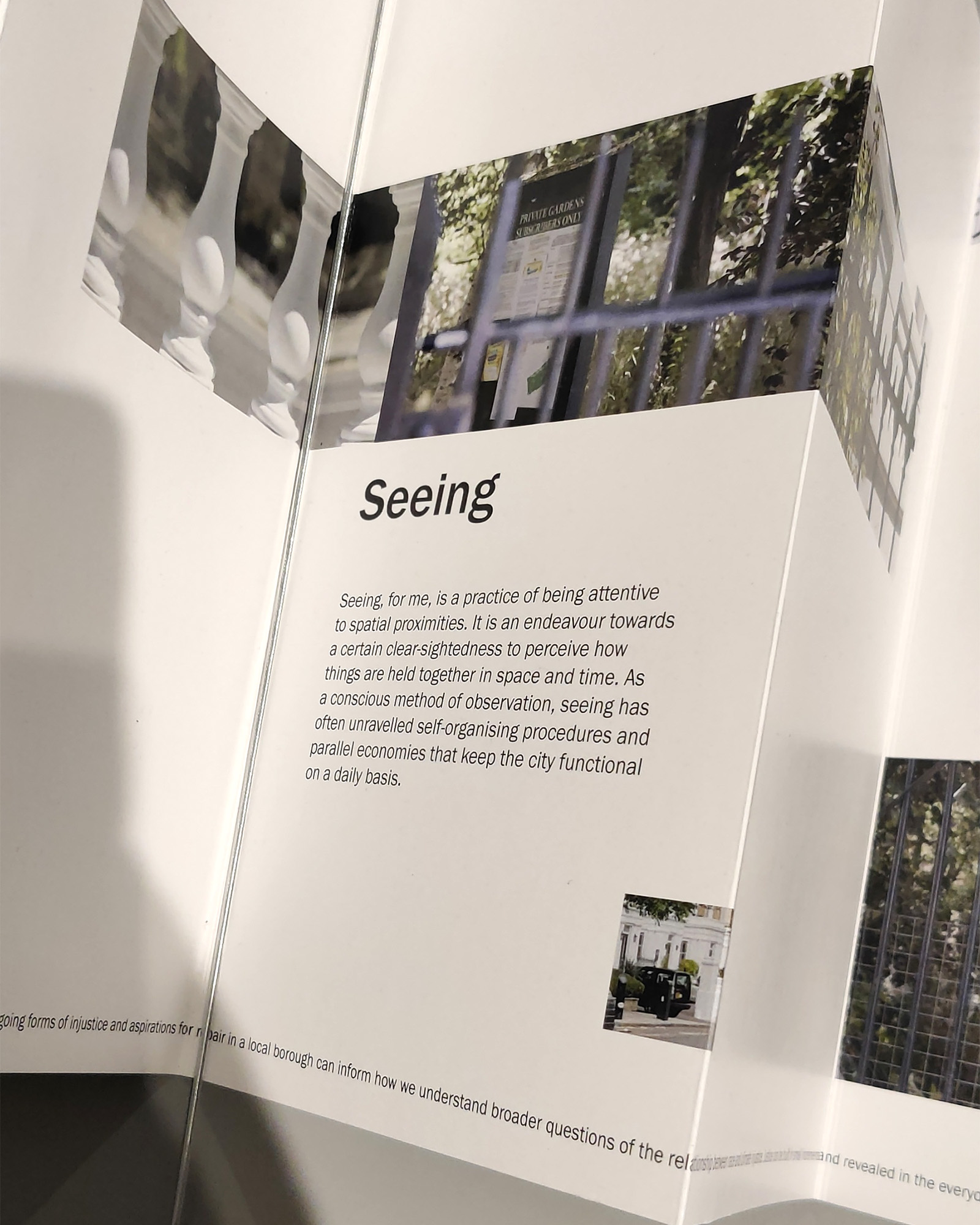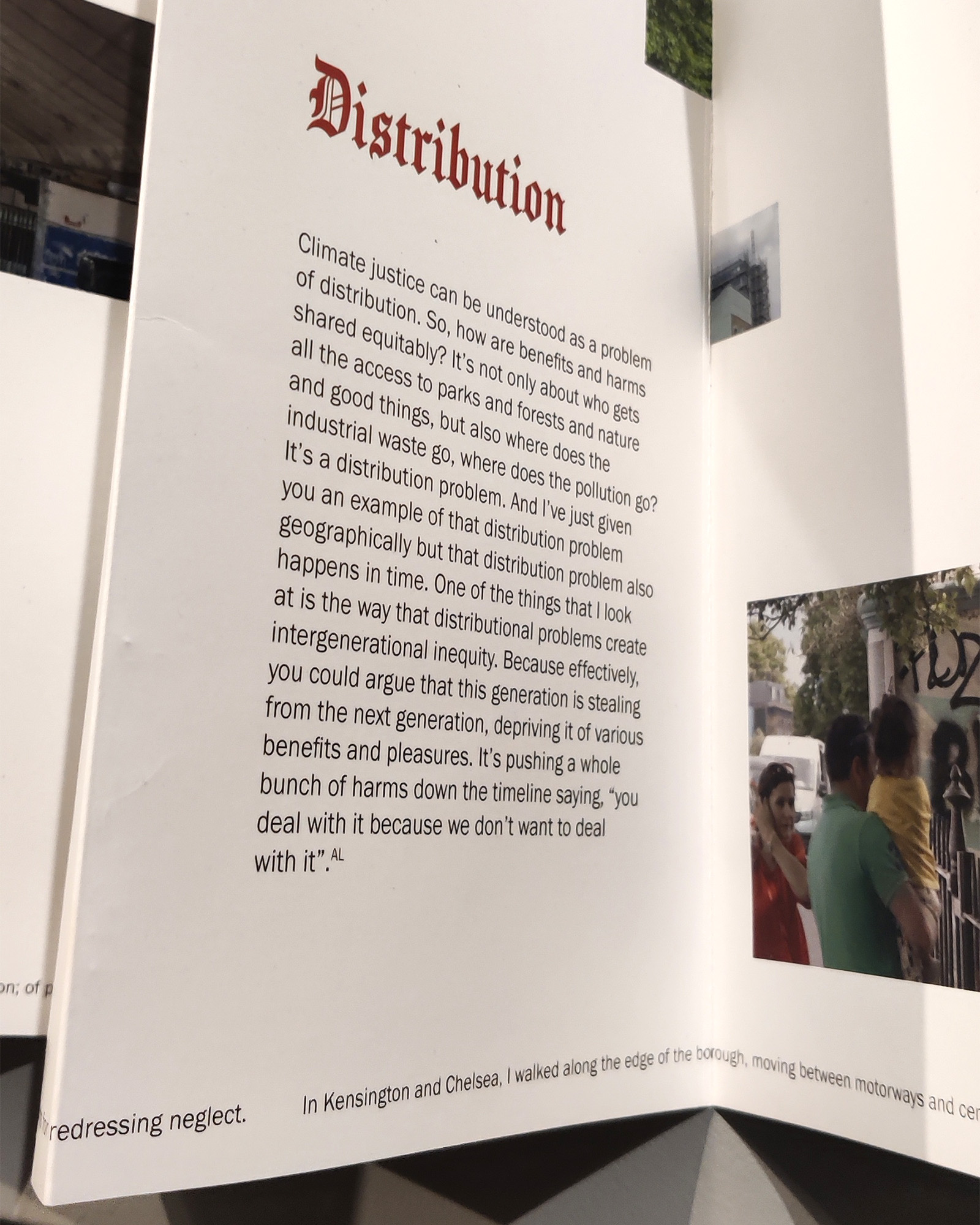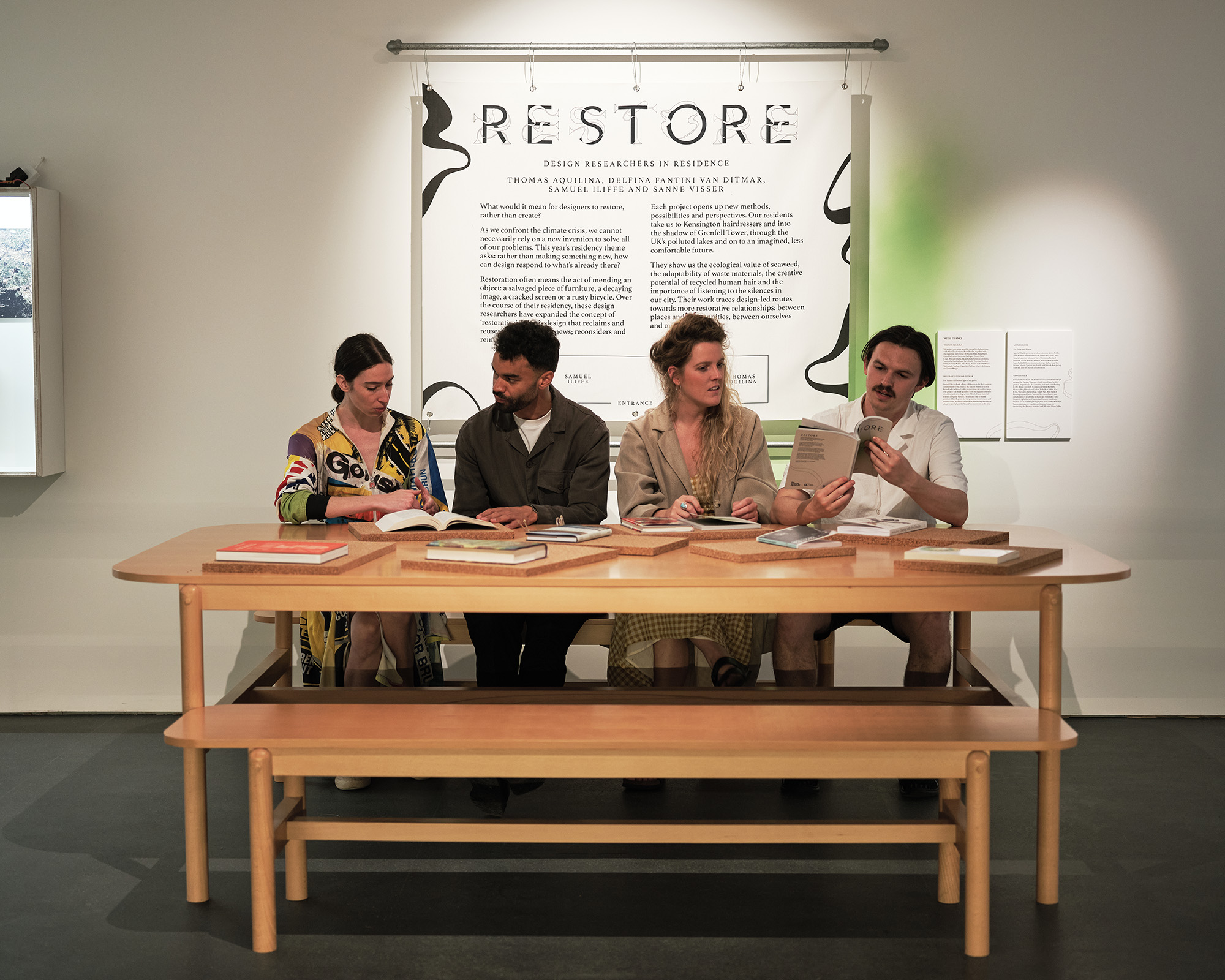Intently observing shadows: Thomas Aquilina in conversation
As one of the four current Design Researchers in Residence in London’s Design Museum, architect, educator & writer Thomas Aquilina is exhibiting a project using walking & talking as a strategy to consider place. In conversation with Will Jennings, Aquilina discusses how his approach could be a valuable tool for architects or general public to define & learn communities.
London is rarely considered a beautiful city. It may have postcard
moments and discrete examples of beauty in park, architecture, place, or
people, but it’s often a chaotic mess of juxtaposition, clashing styles, and rendered
tectonics of power, wealth, and control. Arguably, however, this makes it a
more interesting place than one that can simply be signed off as beautiful, and
what is beauty in place and architecture anyway, is it solely of the visual domain?
Thomas Aquilina is an architect, educator, and writer who has recently completed a stint as one of four Design Researchers in Residence in London’s Design Museum. The work he has made, titled Silent and Speaking, is currently on display and explores a lot of the ideas which fall between the cracks in the city, issues covered up by shiny new hoardings or a PR spin of place, and in it he asks a question: “where do we stand on beauty?”
![]()
fig.i
He explains this further, connecting beauty to the issue of injustice, “I do have questions of thinking about these terms, actually comes back to aesthetics in a way, and it comes back to really: who has right to beauty?” The research has all been about thinking about these terms, and many more besides, selecting a range of words as hooks into the city, words which may mutate meaning over generations, apply themselves differently to different territories, or have a variety of meanings depending on who is reading.
Seeing. Square. Injustice. Resistance. Scale. Land. Gardening. Community. Distribution. Power. Some words which appear to have absolute meanings, others more oblique, but all here considered as a lens to look at the North Kensington area of the city, with some of the nation’s highest differentials of wealth and inequality in proximity, a space of varied architectures, of deeply diverse demographics, and of recent tragedy – “I wanted to explore the triangle between race, space, and climate.”
![]()
![]()
![]()
![]()
Aquilina embarked on a series of walks, always starting from the Design Museum and heading northwards on routes around the borough to consider these words in situ and “observe injustice - environmentally spatially and racially - in the spaces through the neighbourhood.” It is not a capital-P political book, but to discuss these terms Aquilina says that one “cannot not be political, when engaging in this territory, the spaces in and around the shadows – think about the issue of the removal of social housing that was a perfectly good housing stock.”
![]()
Many walks were alone, with his thoughts, critical eye, and camera, while four were with carefully selected companions: Labour Councillor Emma Dent Coad, curator and writer Ekow Eshun, gardener Tayshan Hayden-Smith, and architect and academic Adrian Lahoud. Each either knew and had their own perspectives of the area, or were visiting blind and engaging in new conversation with Aquilina in response to his frames of reference.
These walks and conversations were also recorded, seven hours of footage edited down into a fifteen-minute study of place, the four conversations overlapping and playing with the captured landscapes. Aquilina describes this sonic layer upon the filmic study: “You'll hear the four companions in conversation with me. To me, it was really important that the act of walking was a way to hold difficult conversations about the city and with other people, and the act of walking was a way to be in the neighbourhood and to think about the sort of spatial proximity, to look really attentively.”
The Design Museum catalogue printed to coincide with the Researchers’ final presentations includes Aquilina’s walking-conversation with Ekow Eshun. “Cities are such weird places because they spend so much time building on their own foundations and building on their own past,” Eshun states. “And even stuff that is visible, and not erased, becomes invisible. Even stuff that’s physically present is often lost to sight just by familiarity.”
Eshun weaves his own knowledge of art history, race, and place into the explored streets, as does Hayden-Smith who is from the area and became passionate about plants and gardening after the 2017 Grenfell Tower tragedy, going on to initiate the Grenfell Garden of Peace. Considering Eshun’s thoughts on in/visibility, the Grenfell Tower is both present and absent in Aquilina’s film. A central section of the film discusses the disaster and its impact on place and people, but the building itself is consciously not captured – though it always casts a shadow. The Westway road occludes vantage of the tower, it is both visible and invisible, and these conversations and walks are exercises in navigating such nuances of presence.
![]()
fig.vii
A seven-metre-long concertina book charting an amalgamation of the various walks sits on a table, charting a route anybody could traverse over an hour and a half. Along its length, over the peaks and troughs of the folds, are an index of the words alongside images, with texts from Aquilina or his collaborators interrogating the meaning of the words in specific locales. “There is a continuous footnote, which is a sort of reflection, a kind of figuring through or working out – I definitely see this is a working book, or set of working definitions,” Aquilina adds.
This is an exhibition about research, not always an easy exercise in making or curating. Aquilina says that he “interestingly, as an architect, I didn't want to think I didn't want to design an intervention,” instead relishing in the value of displaying research and idea development to an audience who perhaps are more used, in a museum setting, to considering completed objects or projects. “That was important to me, because I think as architects were trained to put things on the wall, we're trained to bring along a really thick book to show a depth for thinking, but actually what I wanted to do here was to allow the visitor to take something away, to read terms – like land, beauty, justice or border – to make their own relations between them.”
As an academic and architect, Aquilina was exploring a new site and a new method of research, but it is an approach to place which can be adopted by anybody: to assign themselves keywords, then as a Situationist head out to consider their meaning in a specific location. Aquilina has conducted student workshops in the Design Museum, in which along a group walk he stops at a certain predetermined time “minute 44, for example, and I will speak about recognition, or similarly I'll stop minutes later and talk about border,” using definitions from this research to bring in new and multiple voices. Within these layered meanings, interpretations, and thinking, a new idea of beauty might emerge.
![]()
fig.viii
Thomas Aquilina is an architect, educator, and writer who has recently completed a stint as one of four Design Researchers in Residence in London’s Design Museum. The work he has made, titled Silent and Speaking, is currently on display and explores a lot of the ideas which fall between the cracks in the city, issues covered up by shiny new hoardings or a PR spin of place, and in it he asks a question: “where do we stand on beauty?”

fig.i
He explains this further, connecting beauty to the issue of injustice, “I do have questions of thinking about these terms, actually comes back to aesthetics in a way, and it comes back to really: who has right to beauty?” The research has all been about thinking about these terms, and many more besides, selecting a range of words as hooks into the city, words which may mutate meaning over generations, apply themselves differently to different territories, or have a variety of meanings depending on who is reading.
Seeing. Square. Injustice. Resistance. Scale. Land. Gardening. Community. Distribution. Power. Some words which appear to have absolute meanings, others more oblique, but all here considered as a lens to look at the North Kensington area of the city, with some of the nation’s highest differentials of wealth and inequality in proximity, a space of varied architectures, of deeply diverse demographics, and of recent tragedy – “I wanted to explore the triangle between race, space, and climate.”




figs.ii-v
Aquilina embarked on a series of walks, always starting from the Design Museum and heading northwards on routes around the borough to consider these words in situ and “observe injustice - environmentally spatially and racially - in the spaces through the neighbourhood.” It is not a capital-P political book, but to discuss these terms Aquilina says that one “cannot not be political, when engaging in this territory, the spaces in and around the shadows – think about the issue of the removal of social housing that was a perfectly good housing stock.”

fig.vi
Many walks were alone, with his thoughts, critical eye, and camera, while four were with carefully selected companions: Labour Councillor Emma Dent Coad, curator and writer Ekow Eshun, gardener Tayshan Hayden-Smith, and architect and academic Adrian Lahoud. Each either knew and had their own perspectives of the area, or were visiting blind and engaging in new conversation with Aquilina in response to his frames of reference.
These walks and conversations were also recorded, seven hours of footage edited down into a fifteen-minute study of place, the four conversations overlapping and playing with the captured landscapes. Aquilina describes this sonic layer upon the filmic study: “You'll hear the four companions in conversation with me. To me, it was really important that the act of walking was a way to hold difficult conversations about the city and with other people, and the act of walking was a way to be in the neighbourhood and to think about the sort of spatial proximity, to look really attentively.”
The Design Museum catalogue printed to coincide with the Researchers’ final presentations includes Aquilina’s walking-conversation with Ekow Eshun. “Cities are such weird places because they spend so much time building on their own foundations and building on their own past,” Eshun states. “And even stuff that is visible, and not erased, becomes invisible. Even stuff that’s physically present is often lost to sight just by familiarity.”
Eshun weaves his own knowledge of art history, race, and place into the explored streets, as does Hayden-Smith who is from the area and became passionate about plants and gardening after the 2017 Grenfell Tower tragedy, going on to initiate the Grenfell Garden of Peace. Considering Eshun’s thoughts on in/visibility, the Grenfell Tower is both present and absent in Aquilina’s film. A central section of the film discusses the disaster and its impact on place and people, but the building itself is consciously not captured – though it always casts a shadow. The Westway road occludes vantage of the tower, it is both visible and invisible, and these conversations and walks are exercises in navigating such nuances of presence.

fig.vii
A seven-metre-long concertina book charting an amalgamation of the various walks sits on a table, charting a route anybody could traverse over an hour and a half. Along its length, over the peaks and troughs of the folds, are an index of the words alongside images, with texts from Aquilina or his collaborators interrogating the meaning of the words in specific locales. “There is a continuous footnote, which is a sort of reflection, a kind of figuring through or working out – I definitely see this is a working book, or set of working definitions,” Aquilina adds.
This is an exhibition about research, not always an easy exercise in making or curating. Aquilina says that he “interestingly, as an architect, I didn't want to think I didn't want to design an intervention,” instead relishing in the value of displaying research and idea development to an audience who perhaps are more used, in a museum setting, to considering completed objects or projects. “That was important to me, because I think as architects were trained to put things on the wall, we're trained to bring along a really thick book to show a depth for thinking, but actually what I wanted to do here was to allow the visitor to take something away, to read terms – like land, beauty, justice or border – to make their own relations between them.”
As an academic and architect, Aquilina was exploring a new site and a new method of research, but it is an approach to place which can be adopted by anybody: to assign themselves keywords, then as a Situationist head out to consider their meaning in a specific location. Aquilina has conducted student workshops in the Design Museum, in which along a group walk he stops at a certain predetermined time “minute 44, for example, and I will speak about recognition, or similarly I'll stop minutes later and talk about border,” using definitions from this research to bring in new and multiple voices. Within these layered meanings, interpretations, and thinking, a new idea of beauty might emerge.

fig.viii
Thomas Aquilina is an architect and academic dedicated to building communities of radical thought and progressive practice. He is a co-director of the New Architecture Writers programme and is a co-founder of publishing collective Afterparti. He holds the Stephen Lawrence Day Foundation Fellowship at the London School of Architecture and is associate lecturer at London Metropolitan University.
www.thomasaquilina.com
The Design Museum Design Researchers in Residence programme supports emerging
design thinkers at the start of their careers to spend a year developing a
new research project in response to a theme. It builds upon the Design Museum’s flagship designers’ residence which has supported emerging designers since 2007. Previous alumni include Asif Khan, Adam Nathaniel Furman, Jade Folawiyo and Lawrence Lek. It is part of the Museum’s Future
Observatory programme, a new national design research programme based at and coordinated by The Design Museum and supported by the Arts and Humanities Research Council, part of UK Research and Innovation.
The open call for 2022-23 Researchers. with the theme Islands, is open until 19 September
www.designmuseum.org/learning-and-research/design-museum-rd/future-observatory/design-researchers-in-residence-202223-open-call
Will Jennings is a London based writer, visual artist, and educator interested in cities, architecture, and culture. He has written for the RIBA Journal, the Journal of Civic Architecture, Quietus, The Wire, the Guardian, and Icon. He teaches history and theory at UCL Bartlett and Greenwich University, and is director of UK cultural charity Hypha Studios.
www.willjennings.info
design thinkers at the start of their careers to spend a year developing a new research project in response to a theme. It builds upon the Design Museum’s flagship designers’ residence which has supported emerging designers since 2007. Previous alumni include Asif Khan, Adam Nathaniel Furman, Jade Folawiyo and Lawrence Lek. It is part of the Museum’s Future Observatory programme, a new national design research programme based at and coordinated by The Design Museum and supported by the Arts and Humanities Research Council, part of UK Research and Innovation.
The open call for 2022-23 Researchers. with the theme Islands, is open until 19 September
www.designmuseum.org/learning-and-research/design-museum-rd/future-observatory/design-researchers-in-residence-202223-open-call
Will Jennings is a London based writer, visual artist, and educator interested in cities, architecture, and culture. He has written for the RIBA Journal, the Journal of Civic Architecture, Quietus, The Wire, the Guardian, and Icon. He teaches history and theory at UCL Bartlett and Greenwich University, and is director of UK cultural charity Hypha Studios.
www.willjennings.info
visit
Design Researchers in Residence: Restore, is a free exhibition at the Design Museum until 25 September 2022. Alongside Thomas Aquilina’s work, Delfina Fantina van Ditmar uses waste material to form experimental clothing and furniture, Samuel Iliffe exhibits a seaweed farm designed to address freshwater pollution, and Sanna Visser proposes that by collecting hair cut at local hairdressers a new versatile material could be processed and utlised.
More information: www.designmuseum.org/learning-and-research/design-museum-rd/future-observatory/design-researchers-in-residence-restore
images
fig.i Installation view at Design Researchers in Residence: Restore.
©
Felix Speller for the Design Museum.
figs.ii-v Details of Thomas Aquilina’s book within Design Researchers in Residence: Restore. © Will Jennings
figs.vi,vii
Installation view at Design Researchers in Residence: Restore.
© Felix Speller for the Design Museum.
fig.viii The four Design Museum Design Researchers in Residence - Left to right: Delfina Fantini van Ditmar, Thomas Aquilina, Sanne
Visser, Samuel Illife.
©
Felix Speller for the Design Museum
publication date
02 September 2022
tags
Thomas Aquilina, Book, Conversation, Emma Dent Coad, Design Museum, Ekow Eshun, Film. Gentrification, Grenfell Tower, Tayshan Hayden-Smith, Injustice, Kensington, Adrian Lahoud, London, Looking, North Kensington, Politics, Power, Recognition, Research, Text, Walking, Writing
More information: www.designmuseum.org/learning-and-research/design-museum-rd/future-observatory/design-researchers-in-residence-restore


